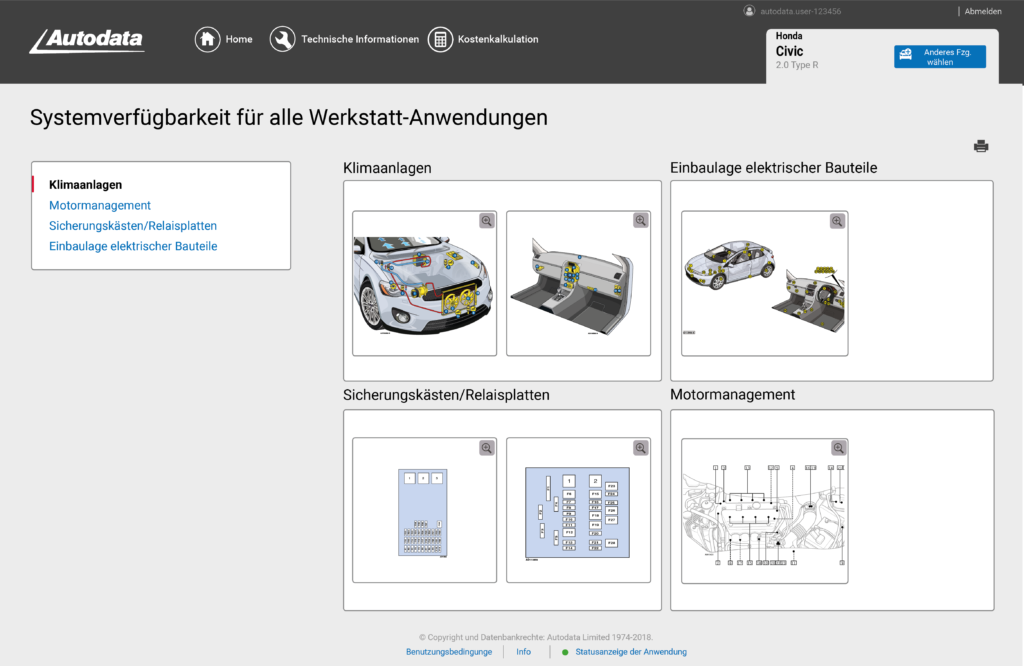
Ever notice a steering wheel seems misaligned when trying to drive in a straight line or a vehicle pulls to one side? If the answer is yes, this could well be the classic signs of wheel alignment problems.
Steering problems generally tend to occur with the aging and wearing of components. Nevertheless, they also can be caused by potholes, driving over curbs, and most certainly after a vehicle is involved in a major accident.
Wheel alignment, also known as steering geometry, is the procedure required to check and, if necessary, adjust settings once they have deviated from the manufacturers’ specifications. However, it is also important to bear in mind, if after a steering inspection there is cause for re-alignment, not all values are adjustable. Whenever noticeable deviations from pre-defined settings are observed, the only remedial procedure available could well be component replacement.
Here we take a look at a few wheel alignment essentials from the technical experts at Autodata to help you in your service, maintenance, and diagnostic work.
Camber angle:
1, Negative camber. 2, Wheel vertical centre line. 3, Positive camber.
Camber angle is the direction the front wheel is leaning relative to the wheel’s vertical centre line and, depending on the lean, the camber angle is either positive or negative. To explain in more detail, when observed from the front of the vehicle, if the top of the wheel is leaning toward the engine, this is considered as negative camber. Conversely, if the top of the wheel is leaning outward, this denotes positive camber.
If during a steering-geometry examination, the measurements are outside specified tolerances and the camber angle needs amending, look for evidence of elongated holes on the suspension strut tower, or eccentric bolts or washers securing the upper and lower control arms as a means of adjustment. In their absence, scrutiny of the suspension and steering components is essential to check for any potential damage.
Castor angle:
1, Negative castor. 2, Wheel vertical centre line. 3, Positive castor.
Castor angle refers to the positioning of the steering axis centre line from the vertical centre line when viewed from the side of the vehicle. If the steering axis centre line contacts the road surface ahead of the wheel’s vertical centreline, this is said to be positive castor. Whereas, negative castor implies the steering axis centre line contacts the road surface behind the wheel’s vertical centre line.
Most modern vehicles are designed with positive castor. This, in conjunction with the other geometry angles, reduces steering effort and allows the front wheels to self-straighten after a bend is negotiated.
Yet, to avert the vehicle from wandering toward the curb side because of the apex in present day roads, the average vehicle castor and camber angles, also called cross castor and cross camber, can sometimes be set at slightly opposed settings from left to right depending on which side of the road the vehicle is driven.
In most contemporary vehicles the castor angle is non-adjustable; nonetheless, aftermarket kits do exist that can be tailored to the suspension to permit castor-angle alteration.
King pin inclination (KPI):
1, King pin inclination
King pin inclination (KPI), also called steering axle inclination (SAI), is achieved differently depending on the suspension arrangement. Typically, with the MacPherson strut suspension, KPI is attained by leaning the strut. With control-arm suspension, the angle of the upper and lower swivel joint pivots is offset.
Because KPI is non-adjustable, it can often be left unchecked or overlooked in collision situations. Incorrect KPI caused by worn or damaged suspension components usually results in accelerated tyre wear along with poor directional stability and increased steering effort – particularly when the vehicle is implementing a parking manoeuvre.
Toe-in and toe-out:
1, Toe-in. 2, Vehicle centre line. 3, Toe-out.
Toe-in and toe-out, commonly referred to in automotive terms as tracking, is the most frequent steering adjustment undertaken. This is the degree to which the leading edge of the front wheels steer out or in from the vehicle centre line when observed from the front. Wheels pointing in toward the vehicle centre line is called toe-in whereas, wheels pointing away from the vehicle centre line are identified as toe-out.
Making sure the vehicle’s toe-in or toe-out measurement is correct offers many advantages, including improved straight-line stability, better road-handling characteristics, and more effective steering response.
Should it be necessary, this adjustment will also allow minor tweaks to correct suspension bush disparities caused in production or by accepted wear levels. If adjustment is needed, it is worthwhile remembering to adjust the track rods equally. Although there is one notable exception to the rule, which requires repositioning of a misaligned steering wheel by minutely adjusting one track rod more than the other.
Guaranteeing precise steering alignment is vital in prolonging the life of tyres and ensuring vehicle stability. Regular wheel alignment checks are advisable and not only when changing worn tyres, steering, or suspension components. Checks should also be carried out if subframe removal is required to facilitate gearbox or clutch repair work.
Finally, it must be pointed out that rear wheels can influence steering stability as well. It’s possible to have front steering angles correctly aligned and still have a vehicle that pulls to one side or displays abnormal tyre-wear patterns. In such circumstances, it is imperative that rear wheels are also considered when confronted with a vehicle experiencing unusual tyre wear or stability issues.
Autodata has a dedicated Wheel Alignment module to further assist technicians with wheel-alignment procedures and help provide workshops with an additional revenue stream. Within the module there is a comprehensive guide that includes information on subjects such as camber angle, ride height, tyres, and adjustment procedures together with manufacturer-specific data.